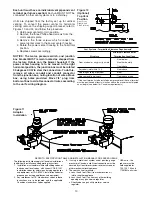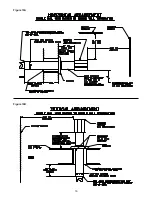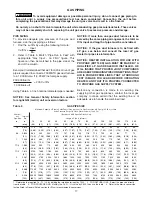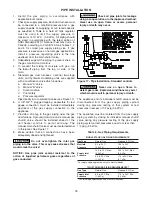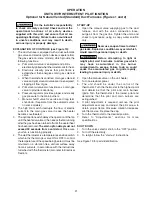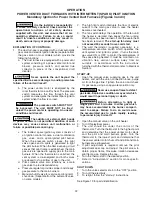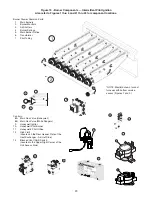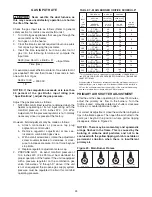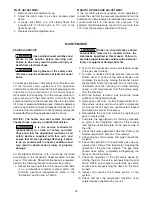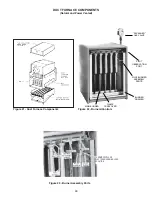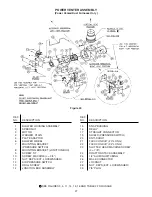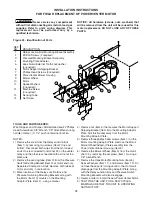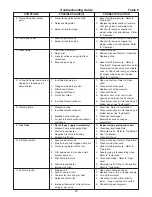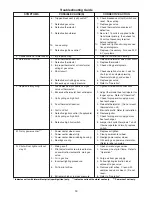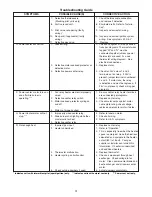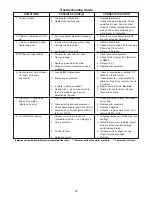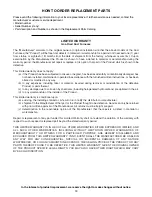
24
TABLE 7 - MAIN BURNER ORIFICE SCHEDULE*
PRIMARY AIR SHUTTER ADJUSTMENT
After the unit has been operating for at least 15 minutes,
adjust the primary air flow to the burners. Turn the
friction-locked, manually-rotated air shutters clockwise
to close, or counterclockwise to open.
For correct air adjustment, close the air shutter until yellow
tips in the flame appear. Then open the air shutter to the
point just beyond the position where yellow tipping
disappears. Refer to Figure 20.
NOTICE: There may be momentary and spasmodic
orange flashes in the flame. This is caused by the
burning of airborne dust particles, and not to be
confused with the yellow tipping, which is a stable or
permanent situation when there is insufficient
primary air.
Figure 20 - Main Burner Flames
GAS INPUT RATE
Never overfire the duct furnace, as
this may cause unsatisfactory operation or shorten
the life of the heater.
Check the gas input rate as follows (Refer to general
safety section for metric conversions/SI units):
1.
Turn off all gas appliances that use gas through the
same meter as the heater.
2.
Turn gas on to the heater.
3.
Clock the time in seconds required to burn one cubic
foot of gas by checking the gas meter.
4.
Insert the time required to burn one cubic foot of
gas into the following formula and compute the
input rate.
3600 (Sec. Per Hr.) x Btu/Cu. Ft
= Input Rate
Time (Sec.)
For example, assume the Btu content of one cubic foot of
gas equalled 1000 and that it takes 18 seconds to burn
one cubic foot of gas.
3600 x 1000
= 200,000
18
NOTICE: If the computation exceeds or is less than
95 percent of the gas Btu/hr. input rating (see
“Specifications”), adjust the gas pressure.
Adjust the gas pressure as follows:
1.
NATURAL GAS: Best results are obtained when the
heater is operating at its full input rating with the
manifold pressure of 3.5 inches W.C. (0.9 kPa).
Adjustment of the pressure regulator is not normally
necessary since it is preset at the factory.
However, field adjustment may be made as follows:
a.
Attach manometer at pressure tap plug
adjacent to control outlet.
b.
Remove regulator adjustment screw cap,
located on combination gas valve.
c. With a small screwdriver, rotate the adjustment
screw counterclockwise to decrease or clock-
wise to increase pressure. Do not force beyond
stop limits.
d. Replace regulator adjustment screw cap.
2.
PROPANE GAS: An exact manifold pressure of
10.0 inches WC (2.5 kPa) must be maintained for
proper operation of the heater. If the unit is equipped
with a pressure regulator on the combination gas
valve, follow steps “a” through “d” above. If the unit
is not so equipped, the propane gas supply system
pressure must be regulated to attain this manifold
operating pressure.
FT
3
/HR
ORIFICE DRILL
FT
3
/HR
ORIFICE DRILL
FT
3
/HR
ORIFICE DRILL
*
INPUT
IN
1000
BTU
NO. OF
BURNER
ORIFICES
3.5" W.C.
(0.9 kPa)
1
0.0" W.C.
(2.5 kPa)
MANIFOLD
PRESSURE
PROPANE
TYPE OF GAS
NATURAL
2500 BTU/Ft
3
(93.1 MJ/m
3
)
1075 BTU/Ft
3
(40.1 MJ/m
3
)
HEATING
VALUE
100
125
150
175
200
225
250
300
350
400
4
5
6
7
8
9
10
12
14
16
96
42
120
42
140
42
163
42
186
42
210
42
233
42
280
42
326
42
372
42
40
54
50
54
60
54
70
54
80
54
90
54
100
54
120
54
140
54
160
54
FT
3
/HR
ORIFICE DRILL
FT
3
/HR
ORIFICE DRILL
FT
3
/HR
ORIFICE DRILL
FT
3
/HR
ORIFICE DRILL
FT
3
/HR
ORIFICE DRILL
FT
3
/HR
ORIFICE DRILL
FT
3
/HR
ORIFICE DRILL
* This schedule is for units operating at normal altitudes of 2000 ft. (610m) or
less. SPECIAL ORIFICES ARE REQUIRED FOR INSTALLATIONS ABOVE
2000 FEET (610M).
When installed in Canada, any references to deration at altitudes in excess of
2000 feet (610m) are to be ignored. At altitudes of 2000 to 4500 feet (610 to
1372m), the unit heaters must be orificed to 90% of the normal altitude rating,
and be so marked in accordance with the CSA certification.
LIFTING
(TOO MUCH AIR)
YELLOW TIPPING
(MARGINAL)
NORMAL
(HARD FLAME)
YELLOW FLAME
(TOO LITTLE AIR)
Summary of Contents for NATURAL INDOOR GAS-FIRED DUCT FURNACE
Page 14: ...14 Figure 12A Figure 12B...
Page 15: ...15 Figure 13A Figure 13B...
Page 34: ...34 NOTES...
Page 36: ......




